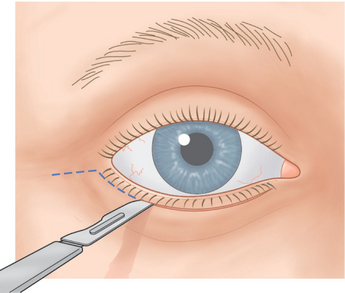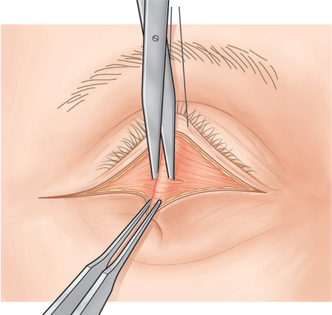CHAPTER 16 Treatment of Lower Eyelid Dermatochalasis, Herniated Orbital Fat, and Hypertrophic Orbicularis Muscle
Skin-Muscle Flap Approach
A skin-muscle flap approach to removal of lower eyelid skin and fat was my favorite approach until about five or so years ago. I now believe that whenever the orbicularis oculi muscle can be preserved, there are advantages in eliminating postoperative eyelid retraction and ectropion as well as possibly decreasing postoperative edema from lymphatic drainage interruption. I, therefore, find that I am removing or repositioning lower eyelid orbital fat through an internal transconjunctival approach and removing and tightening lower eyelid skin through a skin flap approach combined with a lateral orbicularis flap lift. I tend to limit the skin-muscle flap approach to selected patients who have excessive lower eyelid skin and orbicularis usually associated with cheek bags and festoons who choose not to have a cheek–midface lift (Chapter 17). It is also useful when combined with a capsulopalpebral advancement entropion procedure. It is also rare that I do this approach without combining it with a lateral canthal tendon tightening through a tarsal strip procedure. I do believe that in a textbook on cosmetic oculoplastic surgery, it is important to include all forms of treatment including techniques that are more rarely done.
Surgical technique
A No. 15 Bard-Parker blade is used to make a skin incision 1.5 mm beneath the lower lid lashes (Fig. 16-1). The incision begins below the punctum and extends temporally for a distance of 2–3 mm temporal to the lateral canthus. The incision is extended for another 1 cm in an almost horizontal direction.
A 4-0 black silk traction suture is placed through skin, orbicularis muscle, and superficial tarsus of the central lower eyelid and is used to pull the lower eyelid upward. With a toothed forceps, the surgeon grasps the central lower lid at the skin incision site and pulls the eyelid downward and outward. A Westcott scissors is used to penetrate the central orbicularis muscle, with the scissors tips pointed inward and downward (Fig. 16-2). The suborbicularis space should be seen. The Westcott scissors is inserted into the space, and its blades are spread to elongate this dissection.
The traction suture and forceps are kept in the same position as the orbicularis muscle is severed along the incision site with Westcott scissors (Fig. 16-3) or other suitable instrument. A disposable cautery (Solan Accu-Temp, Xomed Surgical Products, Jacksonville, FL), Colorado needle, sapphire-tipped scalpel neodymium : YAG laser, or carbon dioxide laser (see Chapter 22) can also be used.1









